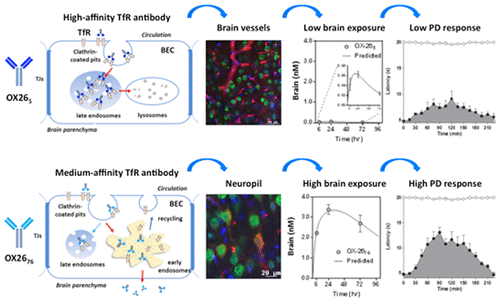当前位置:
X-MOL 学术
›
Mol. Pharmaceutics
›
论文详情
Our official English website, www.x-mol.net, welcomes your feedback! (Note: you will need to create a separate account there.)
Enhanced Delivery of Galanin Conjugates to the Brain through Bioengineering of the Anti-Transferrin Receptor Antibody OX26
Molecular Pharmaceutics ( IF 4.9 ) Pub Date : 2018-02-27 00:00:00 , DOI: 10.1021/acs.molpharmaceut.7b00937 George Thom 1 , Matthew Burrell 1 , Arsalan S. Haqqani 2 , Alvaro Yogi 2 , Etienne Lessard 2 , Eric Brunette 2 , Christie Delaney 2 , Ewa Baumann 2 , Deborah Callaghan 2 , Natalia Rodrigo 1 , Carl I. Webster 1 , Danica B. Stanimirovic 2
Molecular Pharmaceutics ( IF 4.9 ) Pub Date : 2018-02-27 00:00:00 , DOI: 10.1021/acs.molpharmaceut.7b00937 George Thom 1 , Matthew Burrell 1 , Arsalan S. Haqqani 2 , Alvaro Yogi 2 , Etienne Lessard 2 , Eric Brunette 2 , Christie Delaney 2 , Ewa Baumann 2 , Deborah Callaghan 2 , Natalia Rodrigo 1 , Carl I. Webster 1 , Danica B. Stanimirovic 2
Affiliation

|
The blood–brain barrier (BBB) is a formidable obstacle for brain delivery of therapeutic antibodies. However, antibodies against the transferrin receptor (TfR), enriched in brain endothelial cells, have been developed as delivery carriers of therapeutic cargoes into the brain via a receptor-mediated transcytosis pathway. In vitro and in vivo studies demonstrated that either a low-affinity or monovalent binding of these antibodies to the TfR improves their release on the abluminal side of the BBB and target engagement in brain parenchyma. However, these studies have been performed with mouse-selective TfR antibodies that recognize different TfR epitopes and have varied binding characteristics. In this study, we evaluated serum pharmacokinetics and brain and CSF exposure of the rat TfR-binding antibody OX26 affinity variants, having KDs of 5 nM, 76 nM, 108 nM, and 174 nM, all binding the same epitope in bivalent format. Pharmacodynamic responses were tested in the Hargreaves chronic pain model after conjugation of OX26 affinity variants with the analgesic and antiepileptic peptide, galanin. OX26 variants with affinities of 76 nM and 108 nM showed enhanced brain and cerebrospinal fluid (CSF) exposure and higher potency in the Hargreaves model, compared to a 5 nM affinity variant; lowering affinity to 174 nM resulted in prolonged serum pharmacokinetics, but reduced brain and CSF exposure. The study demonstrates that binding affinity optimization of TfR-binding antibodies could improve their brain and CSF exposure even in the absence of monovalent TfR engagement.
中文翻译:

通过反转铁蛋白受体抗体OX26的生物工程增强了甘丙肽结合到大脑的传递。
血脑屏障(BBB)是脑部治疗性抗体传递的巨大障碍。然而,已经开发了针对富含脑内皮细胞的转铁蛋白受体(TfR)的抗体,作为经由受体介导的胞吞途径将治疗性药物递送至大脑的载体。体外和体内研究表明,这些抗体与TfR的低亲和力或单价结合可改善其在BBB腔侧的释放以及靶标在脑实质中的结合。但是,这些研究是利用识别不同TfR表位并具有变化的结合特性的小鼠选择性TfR抗体进行的。在这项研究中,我们评估了具有K D的大鼠TfR结合抗体OX26亲和变异体的血清药代动力学以及大脑和CSF暴露5nM,76nM,108nM和174nM的s都以二价形式结合相同的表位。在OX26亲和变体与止痛肽和抗癫痫药甘丙肽结合后,在Hargreaves慢性疼痛模型中测试了药效学反应。与亲和力为5 nM的变体相比,亲和力为76 nM和108 nM的OX26变体在Hargreaves模型中显示出增强的大脑和脑脊液(CSF)暴露以及更高的效能。将亲和力降低至174 nM会延长血清药代动力学,但会减少大脑和CSF的暴露。该研究表明,即使不存在单价TfR参与,TfR结合抗体的结合亲和力优化也可以改善其大脑和CSF暴露。
更新日期:2018-02-27
中文翻译:

通过反转铁蛋白受体抗体OX26的生物工程增强了甘丙肽结合到大脑的传递。
血脑屏障(BBB)是脑部治疗性抗体传递的巨大障碍。然而,已经开发了针对富含脑内皮细胞的转铁蛋白受体(TfR)的抗体,作为经由受体介导的胞吞途径将治疗性药物递送至大脑的载体。体外和体内研究表明,这些抗体与TfR的低亲和力或单价结合可改善其在BBB腔侧的释放以及靶标在脑实质中的结合。但是,这些研究是利用识别不同TfR表位并具有变化的结合特性的小鼠选择性TfR抗体进行的。在这项研究中,我们评估了具有K D的大鼠TfR结合抗体OX26亲和变异体的血清药代动力学以及大脑和CSF暴露5nM,76nM,108nM和174nM的s都以二价形式结合相同的表位。在OX26亲和变体与止痛肽和抗癫痫药甘丙肽结合后,在Hargreaves慢性疼痛模型中测试了药效学反应。与亲和力为5 nM的变体相比,亲和力为76 nM和108 nM的OX26变体在Hargreaves模型中显示出增强的大脑和脑脊液(CSF)暴露以及更高的效能。将亲和力降低至174 nM会延长血清药代动力学,但会减少大脑和CSF的暴露。该研究表明,即使不存在单价TfR参与,TfR结合抗体的结合亲和力优化也可以改善其大脑和CSF暴露。



























 京公网安备 11010802027423号
京公网安备 11010802027423号